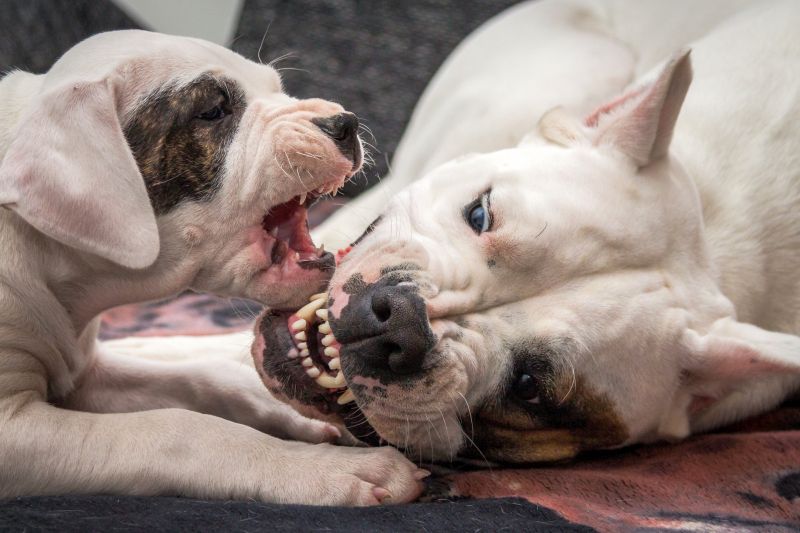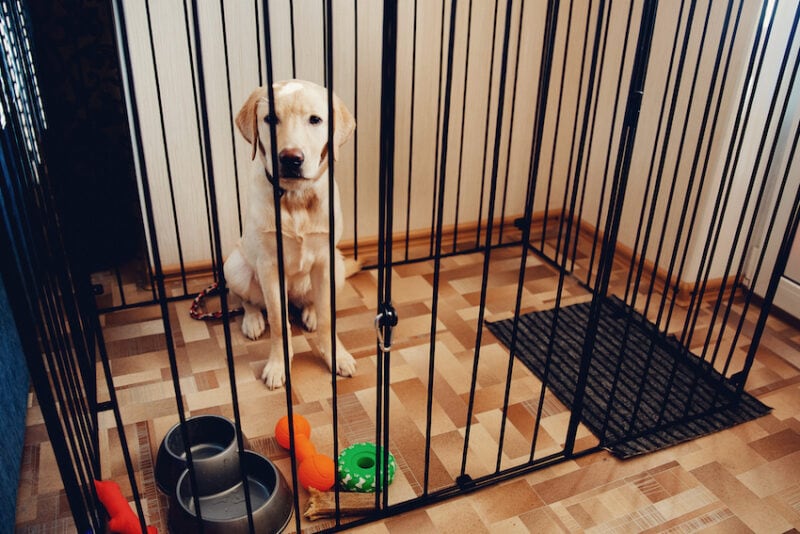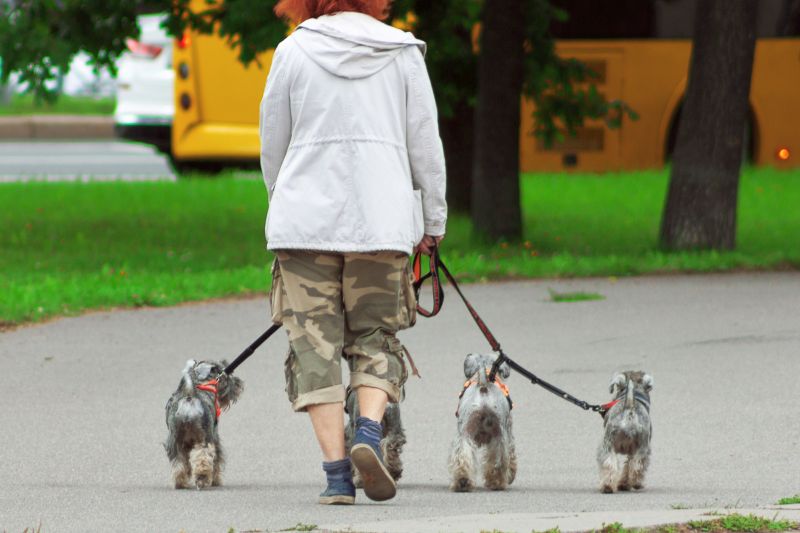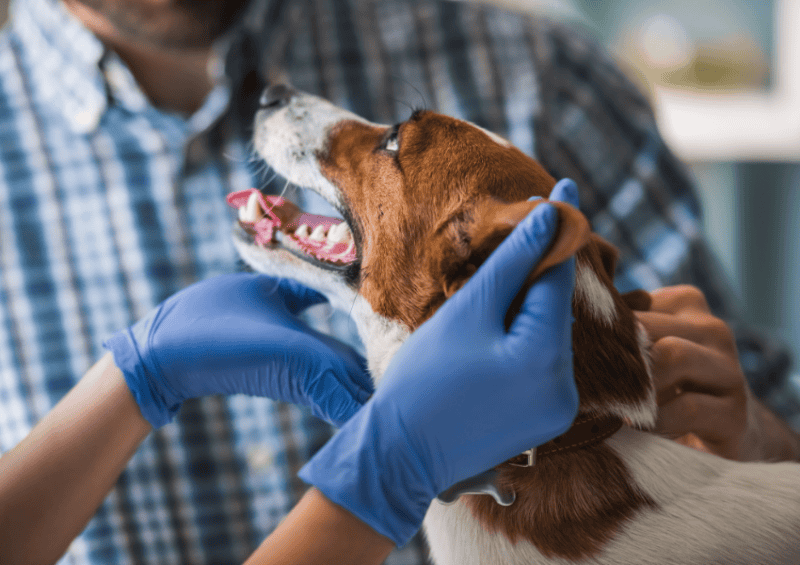How do I recognize fear-based or defensive aggression toward unfamiliar dogs?
This aggression is very common in aggressive encounters with other dogs. The diagnosis is based on the body postures and reaction of the dog when faced with another dog. However, these postures and reactions may change over time depending on the consequences of the interaction. For example, if the dog learns that the aggressive display stops encounters, the behavior tends to increase in intensity and the body postures may become more confident. Therefore, it is important not only to observe the expressions and posturing at the present time, but also those from the initial few encounters. The fearful dog will often have the tail tucked, ears back and may lean against the owner or attempt to get behind them. They may be barking at the approaching dog, while lunging and backing up at the same time. Often the dog is avoiding eye contact. This behavior may begin due to previous aggressive attacks from which the dog could not escape and sustained injury. Some dogs who have had limited or insufficient early socialization with other dogs, may lack the social skills required to interact playfully and comfortably. When multiple dogs are present, if one dog is highly aroused and unable to be calmed or controlled by the owners this dog may incite the second dog to become fearful or defensive, which ultimately leads to aggressive displays from both dogs.
Often the owner plays a role in how the dog behaves. For example, the owner may signal tension via leash tightening responses or even “corrections” that signal the dog that the approaching dog or at least the situation is of concern. In addition, if the owner is frustrated, anxious or worried about the dog’s behavior, then the dog is likely to notice the owner’s reactions and associate them with the approach of the other dog (rather than their own behaviors). This may result in a dog becoming even more defensive and aggressive. An owner that tries to calm their aggressive dog may serve to reinforce the actions the dog is engaging in at the time. Conversely, if the owner threatens or punishes the dog in an attempt to stop the behavior, this will only serve to heighten the dog’s fear and anxiety in relationship to the stimulus. Good control can help to calm the dog; owners who have their dogs restrained on a leash (especially with a choke or pinch collar) and have poor control often will have highly defensive dogs. Dogs that are restrained on a leash or tied up The diagnosis is based on the body postures and reaction of the dog when faced with another dog. are more likely to display aggression when frightened, because they cannot escape.
Why would my dog fight with dogs he has never met?
Generally, most well socialized dogs strive to avoid physical or aggressive confrontation. Dogs use body language to communicate desire to interact or desire to avoid an aggressive encounter. Like people, not all dogs are natural or skilled communicators with members of their ow
Aggression between unfamiliar dogs can be due to fear, poor communication, defensive, possessive behavior over resources (including perhaps family members or other pets) or territorial behavior over territory or owner. Aggression between dogs can result in injury to dogs and/or to the people trying to separate them. The behavior can consist of growling, snarling, barking, lunging, snapping, and biting (see Canine Communication – Interpreting Dog Language).
How Can You Help Your Dogs Get Along Better?

Building back your pups’ once-solid relationship will take some work, but it’s possible in most cases.
As with most canine issues, this is a marathon and not a sprint, so you shouldn’t expect everything to be hunky-dory in no time. You need to take a careful approach and cover all your bases to ensure a happy household once again.
In a multi-dog family, it’s vital to learn dog body language and know the signs of imminent danger or fighting to prevent further issues from happening. When dogs are having a problem with one another, they don’t always “voice” it through growling or barking, so you need to pay attention to their bodies.
Signs of trouble include:
If an actual dog fight ever occurs, never try to separate your dogs using your hands. You may suffer a very serious injury, which will only make the situation worse.
It’s important to note that dog fights often sound a lot worse than they are and are seemingly over before they begin, but that doesn’t mean you should even put yourself in the middle of one.
Instead, grab your dogs’ attention by yelling or blasting an airhorn. You can also throw water or a blanket on the dogs to separate them. If all else fails, use a break stick or other large, hard object to wedge the dogs apart, or use the “wheel barrow” technique if you have a friend who can help (both people essentially grab the legs of a different dog and walk backwards).
Once you know the warning signs of trouble, work on eliminating the underlying stressors that led to the breakdown.
This essentially means addressing the issues and implementing the strategies we discussed earlier, including:
This can also mean giving your dogs a break from one another if they’re getting on one another’s nerves through the use of indoor gates or rotating crate time where one dog is crated for a few hours to rest while the other gets play time and attention from you, and then switching the setup.

While it certainly isn’t ideal, some owners live on a 24/7 dog rotation schedule that implements gates, crates, and household management to ensure that two incompatible dogs are never (or rarely) in the same space at the same time. This isn’t an easy system to manage and can be stressful for the dogs and humans in the home, but it is a possibility and can at the very least be done temporarily while you assess all your other options.
To avoid dog-on-dog conflict, try to dodge trigger stressors at all costs. These are the igniting instances that created the burst of aggression.
For example, if your dogs are snapping at one another around high-value chews or redirecting their frustration during excited backyard play, you’ll want to sidestep these issues.
Some novice owners mistakenly think that they need to let the dog perform the unwanted behavior (in this situation, snapping at the co-habitant dog) and then punish the dog to show that the behavior is unacceptable.
However, this strategy can often backfire, can increase irritation or fear associated with the other dog, and allows your dog to practice the undesired behavior. Whenever dealing with an undesired behavior, your goal should be to prevent the dog from practicing and repeating the behavior while finding an alternative behavior for the dog to engage in instead.
So for this particular situation, you may try distributing treats when the dogs are separate, and make sure to intervene and redirect them when they’re getting over-excited. You may also need to keep all chews, toys, or trigger items out of sight for dogs who resource guard.
It might also mean enjoying one-on-one time in the yard between you and one of the dogs at a time, rather than playing with both dogs together. Doing so will also help you avoid any problems with uncontrolled variables, like the neighbor’s dog, who is known to get your dogs riled up.

It is remarkable how many different problems additional exercise can solve. So, if your dogs are fighting and lack sufficient daily physical and mental exercise, now is the time to pump it up.
Just make sure the exercise if fun! You are trying to wear your pooch out the same way your child may be exhausted after a day at the pool. You don’t want to make your dog trudge on for mile after boring mile, just to make him tired.
Simple walking together will often suffice if you give Spot plenty of time to sniff the roses (or, more likely, pee spots). It can also help restore a pack bond and burn off energy at the same time. Fetch or tug-of-war are both even better (though they may tire you a bit too). You can also look into canine sports like dock-jumping or agility to get their hearts pumping.
Never underestimate the power of touch, either. In addition to telling your dogs how handsome they are, make sure you shower them in rubs and pats. Petting is a calming, reassuring interaction between you and your dogs.
Whether caused by storms, fireworks, or life itself, anxiety is never fun. Dogs with anxiety need to find relief in some form to break the cycle of fear and fear-based aggression.
In some cases, this may mean treating your dogs with medications, natural remedies like CBD oil, or other anxiety-busting tools. Just be sure that you always check with your vet before giving your pups any supplement.
If negative training methods or tools cause anxieties, stop using them entirely and focus on positive reinforcement training to build up your dogs’ confidence and establish a healthy relationship with you. Essentially, this means teaching your dogs how to be the best dogs they can be through reward-based training.
Make sure there is enough love to go around, too, by giving both dogs equal attention.
It can get tricky if you have a puppy demanding love while an older dog hides away to avoid the ruckus, but get creative. Separate them as needed to ensure each gets enough one-on-one time. Play puzzle games with your older dog while your puppy naps, and then practice tricks with your puppy once he wakes up and your older dog is ready to chill on the porch and watch the world go by.
The sky’s the limit — just try things until you stumble upon a working solution.
There’s a reason pups function as wireless alarm clocks on the weekend: They thrive on a schedule.
Your dogs may only be a physical part of your life before and after work, but you are their whole life. It’s important to remember this when you get frustrated with them acting out or getting snippy with one another.
So, work on keeping your schedule as consistent as possible, so your dogs don’t have to stress about why you’re not home for their daily walk or why dinner is three hours late. Consider things like your puppers’ walking, eating, and playing schedule just as important as your work or exercise routine.

As we’ve discussed, you need to rule out medical conditions in both dogs when any aggression is displayed. Not only can aggression be a sign of pain, but it could also be a symptom of a condition, such as hormonal or metabolic imbalances.
Don’t have easy access to a vet? You may want to consider getting help from JustAnswer — a service that provides instant virtual-chat access to a certified vet online.
You can discuss the issue with them, and even share video or photos if need be. The online vet can help you determine what your next steps should be.
While talking with your own vet — who understands the ins and outs of your dog’s history — is probably ideal, JustAnswer is a good backup option.
If you can’t identify what the issues are between your dogs or if you’re not confident in your abilities to develop an improvement plan, reach out to a credentialed animal behaviorist. Often, trained professionals will not only have better solutions to your canine problems, but they will pick up on subtler cues your dogs provide.
This is also essential if your dogs have caused serious harm to one another in the past. Leave these extreme cases to the professionals to ensure a positive outcome.
“Why is my dog SUDDENLY aggressive towards me?” – Dog Trainer Explains
Let’s face it: No matter how social you are, sometimes you need a break from people. And no matter how many friends you have, there will always be people who rub you the wrong way. No one likes everyone else. It’s a fact of life. It’s the same for canines: Not all dogs like all other dogs. “We have a whole spectrum of dogs,” says Dr. Sharon Crowell-Davis, DVM, DACVB, professor in the College of Veterinary Medicine at the University of Georgia. “We have dogs who if they see another dog in the distance, they’ll react aggressively and other dogs who if they see just about any dog up close, they react friendly.” And in between, there is a middle ground — dogs who like some dogs while disliking others. While you might get that your dog, like you, prefers some of his canine peers over others, it can be difficult to make sense of how those choices are made.
To understand how doggie socializing works, Dr. Crowell-Davis explains that we need to go back to the basics of canine communication. “Dogs communicate with each other in ways that we don’t get, that we are just totally blind about,” she says. A dog will see something in another dog’s body language or pick up olfactory clues that signal something the first dog either likes or doesn’t like. And, Dr. Crowell-Davis notes, those subtle body cues and smells can be sensed from a significant distance away. “[Dogs] live in a world of scent information, are surrounded by it. The way we scan a room and see all kinds of details — the bookcase and the book and the chair — they scan the world around them with their nose, and unless the wind is blowing in the totally wrong direction, they pick up a huge amount of olfactory information.” Another possible reason that a dog may take an immediate dislike to another is that dog’s historical experience. If, for example, your dog was attacked by a large white dog, he may exhibit timidity and intense fear aggression toward big white dogs. Unless we are aware of a dog’s history, Dr. Crowell-Davis says, this type of response can seem like a total mystery to us. It works with both bad experiences and good experiences as well. “Other dogs that either look similar or move in a similar fashion or smell similar” to a much-liked canine friend, says Dr. Crowell-Davis, “can affect one dog’s response to another.” Your dog’s behavior may also be about you, Dr. Crowell-Davis explains. “It could be that actually your dog is being protective of you in an almost possessive way and the other dog’s just minding his own business,” she says, and that your dog doesn’t want to be near that dog — or doesn’t want you to be near him.
If your dog’s dislike of certain dogs is intense or problematic — for example, he is aggressive with or fearful of a dog he comes into contact with on a regular basis — you need to take your dog to a veterinary behaviorist. But if it’s something milder, like an occasional avoidance of another canine at the dog park, Dr. Crowell-Davis suggests a lot of positive reinforcement obedience training done in a gradual fashion. “Have the dog sit for a treat, watch you for a treat and then go out on walks. As you’re getting near to another dog, really go in the mode of lots of treats. He will start associating the presence of other dogs with two things: first, with the dog controlling itself so it gets the treats, and second, with getting the treats!” The best way to prevent this kind of dislike from becoming an issue, according to Dr. Crowell-Davis, is to take your new puppy to a good puppy socialization class. She also suggests frequently taking your young and growing dog into situations where he can have pleasant interactions with other dogs. “When you encounter other people with dogs,” Dr. Crowell-Davis says, “ask if their dog is friendly and is it OK if the dogs say hello to each other.” Over time, your puppy can learn to be more of a dog’s dog — or the canine equivalent of a people person.
Sign up and make sure you are always on top of the most important info for you and your pets.